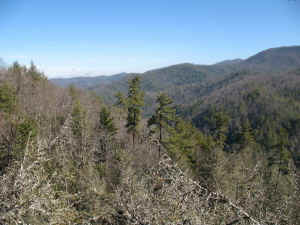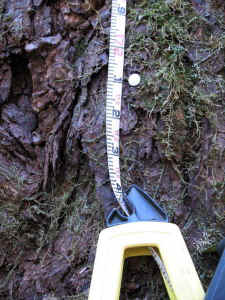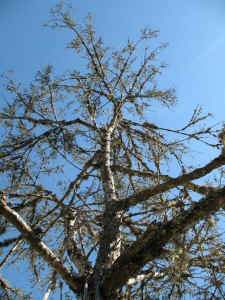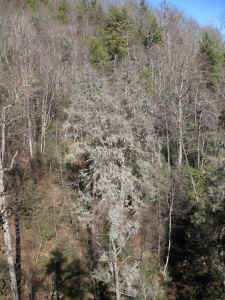ENTS,
The dedicated searching of the Tsuga Search Project has yielded
the first
confirmed eastern hemlock to break 170’ tall. Yesterday I
climbed a hemlock
on Big Fork Ridge in Cataloochee that Jess Riddle found several
weeks ago.
This tree, named the “Survivor”, is one of the few trees
remaining in a
fairly large blowdown, probably from Hurricane Opal in 1995.

It
was quite a
climbing experience in the sense that there were very few trees
surrounding
it so the ground (or rather fallen trunks and young saplings)
were in view
at all times. One side of the tree had very few limbs and the
sense of
height was strong due to the open space. Long range views over
Caldwell Fork
were awesome.

Survivor - Stitch of tree |

First Ascent |
I carried a pole up with me because the top was so thin and
mostly dead
(HWA). The tape drop revealed the height to be 172.1’,
breaking the former
height record by 2.3’! The former record of 169.8’ has held
since 1998 when
Brian Hinshaw and I climbed the “Tsali Hemlock”, also in
Cataloochee. This
tree brings the average height of the top ten eastern hemlocks
known to
169.8’. The range in height of the top ten is only 3.7’, and
eight of these
trees are in the Smokies. The volume of the ancient Survivor
tree is 884
cubes as determined by incremental girth measurements. CBH is
modest at
11’7”, but the extreme height and slow trunk taper (8’1”
at 100’) allows it
to be relatively large for its diameter. However, as far as
volume goes,
this tree is just over ˝ the size of the largest known.

Tape Drop |

Tippy-Top at 172.1 feet |
We have two more trees to climb on this ridge that have been
lasered over
170’. I plan to climb one tomorrow and the other next week.
These two other
trees, though similar in height, couldn’t be more different in
size. One
will be the smallest tree in the project by volume (<500
cubes) whereas the
other will be in the top ten for volume with more than 1300
cubic feet of
wood, perhaps 1350 or more. They also are different in health;
the small one
is already essentially dead from HWA but the larger tree still
has a fairly
full crown and may recover with HWA treatments.

The grove is dead |

Blowdown from above |
Will Blozan
President, Eastern Native Tree Society
President, Appalachian Arborists, Inc.
|